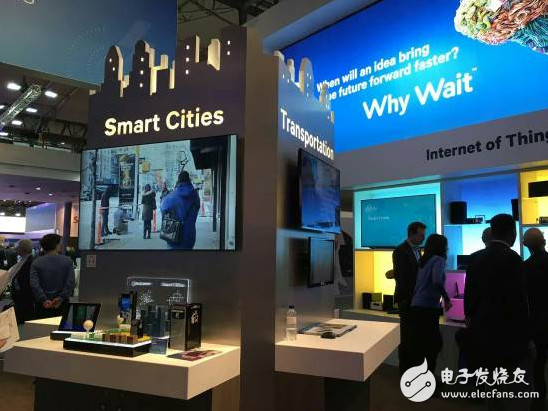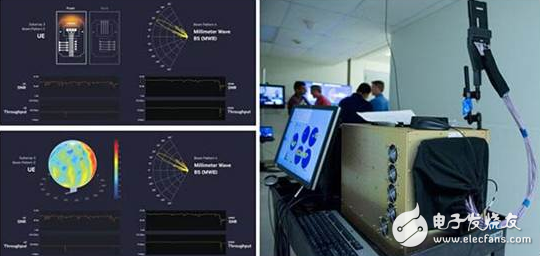The fourth industrial revolution, Internet+, Industry 4.0... Based on the integration of information and physics, the industry is undergoing a major transformation; from a personal perspective, the smartphone we are using has seamless mobile connectivity and Extraordinary computing power, which makes us no longer limited to sitting at the computer. Now and in the future, cars, drones, robots, audio, home, etc. will also become mobile Internet nodes one after another, which will fundamentally change our lives.

(Qualcomm demonstrates its "all things connected" products and technologies at MWC)
There is no doubt that mobile connectivity is one of the underlying technologies that underpin these major changes, and 5G technology is a very important breakthrough – the future 5G network will provide an integrated distribution for computing, storage, network resources and connectivity. platform. This unified connectivity architecture provides higher peak rates, latency down to milliseconds, and lower cost and higher energy efficiency, which will provide the most powerful support for the era of connectivity.
What is the industry doing about 5G?
For the next generation of 5G communication technology, the industry's more consistent goal is to achieve commercial deployment by 2020. In 2015, the global development of 5G technology entered a critical period of technology research and development and standardization preparation. The ITU has completed the key content of the fifth-generation mobile communication name, vision and timetable, and launched the pre-5G standard research this year.

(Qualcomm demonstrates 5G technology during MWC)
In China, the Ministry of Industry and Information Technology said that China's 5G basic R&D trials will be conducted in 2016-2018 to promote the formation of global 5G unified standards and lay the foundation for launching 5G commercials in 2020. At the GTI Summit during MWC, China Mobile joined forces with Qualcomm, Ericsson, Huawei, Nokia, ZTE, Datang, Intel, Keysight, Haier, Hisense and Shougang to launch the 5G Joint Innovation Center. Li Zhengmao, vice president of China Mobile, said: "In the face of future 5G development, the traditional communications industry and vertical industry should be transformed from single-domain innovation to cross-domain collaborative innovation, thereby jointly expanding 5G new markets, tapping new applications, and welcoming 5G. Business opportunities.†Qualcomm CEO Steve Morenkov said that 5G is connecting new industries and creating new user experiences through a unified platform. He also said that Qualcomm's innovative technology is driving the creation of a more powerful unified 5G platform.
Also during MWC, Qualcomm and Ericsson announced that they will collaborate on 5G technology development, early interoperability testing, and coordination with mobile operators for established projects. The two companies will participate in the early testing and validation of 5G key technology components to support the technical work required for standardization of the 3GPP Release 15 specification.
Observing the "technical actions" of Qualcomm, the leading wireless communication technology manufacturer in 5G, will help us to understand more about the future direction of this technology, mainly covering the following aspects: First, the design is based on the optimization of OFDM waveforms. Air interfaces, as well as multiple access with flexible frameworks, can be extended from low frequency bands to millimeter waves, extended from macro station deployments to local hotspots, and support licensed, unlicensed and shared licensed bands from the beginning of development; The new 5G multi-connection technology supports concurrent connectivity and aggregation across 5G, 4G LTE and Wi-Fi technologies, and its multi-access 5G core network ensures that mobile operators can continue to benefit from current investment in the future; Third, Qualcomm defines a flexible network architecture that enables 5G network operators and OTT service providers to quickly and efficiently build customized services to meet the highly variable 5G use cases and extend from low-cost hotspots to wide-area mobile deployments. .
Last year, Qualcomm demonstrated the key to 5G technology, the millimeter wave, that enables the ultimate mobile broadband experience. It demonstrates smart beamforming and beam tracking techniques on site. With this technology, a relatively stable signal-to-noise ratio (SNR) can be obtained even if the device is moved and the RF channel conditions change. The demo graphical user interface (GUI) clearly demonstrates the system's switching between beam types (upstream and downstream) as the environment changes.

(Qualcomm's 28GHz 5G system live demonstration in San Diego)
4G evolution and 5G development synchronization
Of course, 5G will not be produced out of thin air. Qualcomm CEO Steve Morenkov said, "From a product perspective, 5G will be the evolution of 4G, and manufacturers with strong capabilities on 4G can become 5G leaders, which will be reflected in the system design capabilities. And the ability to multi-mode design." In fact, this company has been conducting forward-looking research and development on 5G since 2006.
At present, Qualcomm is working with partners to continue to lead the 4G evolution through LTE-Advanced Pro, bringing the full potential of 4G technology and investment to the maximum benefit. The LTE-Advanced Pro named by the 3GPP Release 13 standard marks the next important stage of 4G, extending the technology to a new application and usage model, laying the foundation for a unified and more powerful connection platform for the next decade.
On the chip, Qualcomm is the first to bring 4G into the Gigabit era. Its newly released Snapdragon X16 LTE modem is the first commercial LTE-Advanced Pro modem and the first Gigabit LTE modem in the mobile industry. "Like fiber" up to 1Gbps LTE Category 16 download speed; it also supports up to 150Mbps upstream speed by supporting up to 2x20MHz uplink carrier aggregation and 64-QAM. The industry generally believes that the Xiaolong X16 not only blurs the boundaries between wired and wireless broadband, but also represents an important step towards 5G.
During the MWC, based on the Opteron X16 modem, Qualcomm and Ericsson demonstrated how to achieve download rates of up to 1 Gbps by utilizing three-carrier aggregation, 4x4 MIMO on two aggregated carriers, and higher-order modulation of 256-QAM.
In addition, Qualcomm is pushing for Access Authorized Access (LAA) and LTE-U technologies to bring cellular network technology to unlicensed bands. Qualcomm brings this technology to industry standards and builds advanced prototypes, and conducts trials with operators. Proper use of licensed and unlicensed spectrum is critical to meeting data needs and providing the best mobile experience to end users as much as possible.
In summary, Qualcomm is actively building a strong 4G LTE technology evolution path and promoting LTE to 5G evolution. LTE-Advanced Pro not only greatly enhances the performance and efficiency of mobile broadband, but also extends LTE to new areas such as unlicensed spectrum and end-to-end communication. In addition, LTE-Advanced Pro will introduce new technologies to expand the boundaries of the LTE space, supporting the rapid development of connected cars, smart cities, smart homes and wearable devices, connecting the world around us. This includes supporting new LTE service types and opening up new opportunities for the entire mobile ecosystem.
Sensor Dustbin Automatic Dustbin
Sensor Dustbin Automatic Dustbin,Automatic Sensor Recycling Dustbin,Stainless Steel Sensor Automatic Dustbin,Automatic Sensor Dustbin
NINGBO ZIXING ELECTRONIC CO.,LTD. , https://www.zixingautobin.com